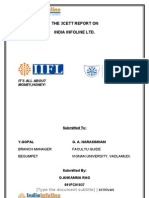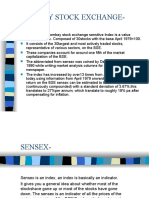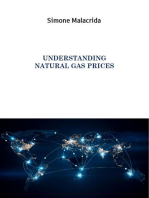Price Rate of Change Indicator (ROC) PDF
Price Rate of Change Indicator (ROC) PDF
Uploaded by
Sandeep MishraCopyright:
Available Formats
Price Rate of Change Indicator (ROC) PDF
Price Rate of Change Indicator (ROC) PDF
Uploaded by
Sandeep MishraOriginal Title
Copyright
Available Formats
Share this document
Did you find this document useful?
Is this content inappropriate?
Copyright:
Available Formats
Price Rate of Change Indicator (ROC) PDF
Price Rate of Change Indicator (ROC) PDF
Uploaded by
Sandeep MishraCopyright:
Available Formats
Price Rate Of Change Indicator (ROC)
The Price Rate of Change (ROC) is a momentum-based technical indicator that measures the
percentage change in price between the current price and the price a certain number of periods
ago. The ROC indicator is plotted against zero, with the indicator moving upwards into positive
territory if price changes are to the upside, and moving into negative territory if price changes are
to the downside.
The indicator can be used to spot divergences, overbought and oversold conditions, and centerline
crossovers.
KEY TAKEAWAYS
• The Price Rate of Change (ROC) oscillator is and unbounded momentum indicator used in
technical analysis set against a zero-level midpoint.
• A rising ROC above zero typically confirms an uptrend while a falling ROC below zero
indicates a downtrend.
• When the price is consolidating, the ROC will hover near zero. In this case, it is important
traders watch the overall price trend since the ROC will provide little insight except for
confirming the consolidation.
The Formula for the Price Rate of Change Indicator Is:
ROC=(Closing Pricep−n Closing Pricep −Closing Pricep−n )×100
where:
Closing Pricep =Closing price of most recent period
Closing Pricep−n =Closing price n periods beforemost recent period
How to Calculate the Price Rate of Change Indicator
The main step in calculating the ROC, is picking the "n" value. Short-term traders may choose a
small n value, such as nine. Longer-term investors may choose a value such as 200. The n value is
how many periods ago the current price is being compared to. Smaller values will see the ROC
react more quickly to price changes, but that can also mean more false signals. A larger value
means the ROC will react slower, but the signals could be more meaningful when they occur.
• Select an n value. It can be anything such as 12, 25, or 200. Short-term trader traders
typically use a smaller number while longer-term investors use a larger number.
• Find the most recent period's closing price.
• Find the period's close price from n periods ago.
• Plug the prices from steps two and three into the ROC formula.
• As each period ends, calculate the new ROC value.
What Does the Price Rate of Change Indicator Tell You?
The Price Rate of Change (ROC) is classed as a momentum or velocity indicator because it
measures the strength of price momentum by the rate of change. For example, if a stock's price at
the close of trading today is $10, and the closing price five trading days prior was $7, then the five-
day ROC is 42.85, calculated as
((10−7)÷7)×100=42.85
Like most momentum oscillators, the ROC appears on a chart in a separate window below the
price chart. The ROC is plotted against a zero line that differentiates positive and negative values.
Positive values indicate upward buying pressure or momentum, while negative values below zero
indicate selling pressure or downward momentum. Increasing values in either direction, positive or
negative, indicate increasing momentum, and moves back toward zero indicate waning
momentum.
Zero-line crossovers can be used to signal trend changes. Depending on the n value used these
signal may come early in a trend change (small n value) or very late in a trend change (larger n
value). The ROC is prone to whipsaws, especially around the zero line. Therefore, this signal is
generally not used for trading purposes, but rather to simply alert traders that a trend change may
be underway.
Overbought and oversold levels are also used. These levels are not fixed, but will vary by the asset
being traded. Traders look to see what ROC values resulted in price reversals in the past. Often
traders will find both positive and negative values where the price reversed with some regularity.
When the ROC reaches these extreme readings again, traders will be on high alert and watch for
the price to start reversing to confirm the ROC signal. With the ROC signal in place, and the price
reversing to confirm the ROC signal, a trade may be considered.
ROC is also commonly used as a divergence indicator that signals a possible upcoming trend
change. Divergence occurs when the price of a stock or another asset moves in one direction while
its ROC moves in the opposite direction. For example, if a stock's price is rising over a period of
time while the ROC is progressively moving lower, then the ROC is indicating bearish divergence
from price, which signals a possible trend change to the downside. The same concept applies if the
price is moving down and ROC is moving higher. This could signal a price move to the upside.
Divergence is a notoriously poor timing signal since a divergence can last a long time and won't
always result in a price reversal.
The Difference Between the Price Rate of Change and the Momentum Indicator
The two indicators are very similar and will yield similar results if using the same n value in each
indicator. The primary difference is that the ROC divides the difference between the current price
and price n periods ago by the price n periods ago. This makes it a percentage. Most calculations
for the momentum indicator don't do this. Instead, the difference in price is simply multiplied by
100, or the current price is divided by the price n periods ago and then multiplied by 100. Both
these indicators end up telling similar stories, although some traders may marginally prefer one
over the other as they can provide slightly different readings.
Limitation of Using the Price Rate of Change Indicator
One potential problem with using the ROC indicator is that its calculation gives equal weight to the
most recent price and the price from n periods ago, despite the fact that some technical analysts
consider more recent price action to be of more importance in determining likely future price
movement.
The indicator is also prone to whipsaws, especially around the zero line. This is because when the
price consolidates the price changes shrink, moving the indicator toward zero. Such times can
result in multiple false signals for trend trades, but does help confirm the price consolidation.
While the indicator can be used for divergence signals, the signals often occur far too early. When
the ROC starts to diverge, the price can still run in the trending direction for some time. Therefore,
divergence should not be acted on as a trade signal, but could be used to help confirm a trade if
other reversal signals are present from other indicators and analysis methods.
You might also like
- Trading Playbook - CL - ExternalDocument39 pagesTrading Playbook - CL - Externalshanghaiboy2015No ratings yet
- Scalping PresentationDocument126 pagesScalping Presentationmihaib2007100% (5)
- Golden Cross Vs Death Cross PDFDocument3 pagesGolden Cross Vs Death Cross PDFSandeep MishraNo ratings yet
- 1 4976997257812377719Document264 pages1 4976997257812377719Dhrubojyoti Sinha100% (11)
- Investment Journey and Key Learnings Kumar SaurabhDocument7 pagesInvestment Journey and Key Learnings Kumar SaurabhAASHAV PATELNo ratings yet
- Evaluation of PortfolioDocument70 pagesEvaluation of PortfolioNiket Dattani100% (1)
- ACF 602/622 Coursework: Group 53Document13 pagesACF 602/622 Coursework: Group 53Shihab HasanNo ratings yet
- Stochastic Oscillator PDFDocument3 pagesStochastic Oscillator PDFSandeep MishraNo ratings yet
- Money Flow Index PDFDocument3 pagesMoney Flow Index PDFSandeep MishraNo ratings yet
- Moving Average (MA) PDFDocument3 pagesMoving Average (MA) PDFSandeep MishraNo ratings yet
- The Top 10 Best Candlestick PatternsDocument41 pagesThe Top 10 Best Candlestick PatternsRDReaver100% (2)
- High Probability Alt-Coin Entry Guide.: TelegramDocument8 pagesHigh Probability Alt-Coin Entry Guide.: TelegramLuis Felipe MartinsNo ratings yet
- Trading With Technical Trend Indicators: Envelopes, Parabolic SAR, Momentum, Average Directional Movement Index (ADX): Trend IndicatorsFrom EverandTrading With Technical Trend Indicators: Envelopes, Parabolic SAR, Momentum, Average Directional Movement Index (ADX): Trend IndicatorsNo ratings yet
- Arbitrage: Search Arbitration Economics Finance / Ɑrbɨtrɑ Ʒ/ Markets Market Prices Cash FlowDocument79 pagesArbitrage: Search Arbitration Economics Finance / Ɑrbɨtrɑ Ʒ/ Markets Market Prices Cash FlowMohsin HayatNo ratings yet
- Investment in Equities Versus Investment in Mutual FundDocument37 pagesInvestment in Equities Versus Investment in Mutual FundBob PanjabiNo ratings yet
- BM Cia3Document15 pagesBM Cia3CHARUL AGRAWAL 1823008No ratings yet
- Comparative Performance Study of Mutual Funds in IndiaDocument66 pagesComparative Performance Study of Mutual Funds in IndiaAnoop Keshari0% (1)
- "General Awareness Regarding Stock Market in Jalandhar.": A Research Report OnDocument53 pages"General Awareness Regarding Stock Market in Jalandhar.": A Research Report OnKirandeep GhaiNo ratings yet
- Indicaters of StocksDocument5 pagesIndicaters of StocksarshadalicaNo ratings yet
- Summer Training Report of Shanky GroverDocument129 pagesSummer Training Report of Shanky GroverRanjan AlokNo ratings yet
- UIT Prospectus 2021Document86 pagesUIT Prospectus 2021timebot00No ratings yet
- Currency Basics: 1.1 - Module OrientationDocument38 pagesCurrency Basics: 1.1 - Module OrientationpajijayNo ratings yet
- How To Calculate IndexDocument5 pagesHow To Calculate Indexmoorthys1966No ratings yet
- Investor Demand For Sell-Side Research: Lawrence@haas - Berkeley.eduDocument57 pagesInvestor Demand For Sell-Side Research: Lawrence@haas - Berkeley.eduBhuwanNo ratings yet
- Overview of Indian Capital MarketDocument23 pagesOverview of Indian Capital MarketShruti PuriNo ratings yet
- A S I P O T N S E O I: Tudy of Nitial Ublic Fferings On HE Ational Tock Xchange F NdiaDocument33 pagesA S I P O T N S E O I: Tudy of Nitial Ublic Fferings On HE Ational Tock Xchange F NdiarhtmhrNo ratings yet
- Real Estate Reset 2020Document46 pagesReal Estate Reset 2020alphaoneNo ratings yet
- Hedge (Finance)Document7 pagesHedge (Finance)deepakNo ratings yet
- wp2012 20Document1 pagewp2012 20Peter FrankNo ratings yet
- Kuwait Finance House AustDocument2 pagesKuwait Finance House AustchairunnisanovNo ratings yet
- PMS Sharpes Single Index Model PDFDocument22 pagesPMS Sharpes Single Index Model PDFRadhika KadamNo ratings yet
- Momentum (Technical Analysis) : For Other Uses of "Momentum", SeeDocument2 pagesMomentum (Technical Analysis) : For Other Uses of "Momentum", SeeAshish TripathiNo ratings yet
- Behavioral Finance Is Investor Psyche Driving Market Performance PDFDocument22 pagesBehavioral Finance Is Investor Psyche Driving Market Performance PDFshubham c100% (1)
- 3 CettDocument37 pages3 Cettsanjana13No ratings yet
- The Anatomy of The Forex Market - Pepperstone InfographicDocument1 pageThe Anatomy of The Forex Market - Pepperstone Infographicadmin2919No ratings yet
- Corporate Restructuring NOTESDocument16 pagesCorporate Restructuring NOTESchand1234567893No ratings yet
- Basics of The Share Market - Stock Market TutorialDocument28 pagesBasics of The Share Market - Stock Market TutorialKalimuthu PaulpandianNo ratings yet
- Chapter 4: Classification & Prediction: 4.1 Basic Concepts of Classification and Prediction 4.2 Decision Tree InductionDocument19 pagesChapter 4: Classification & Prediction: 4.1 Basic Concepts of Classification and Prediction 4.2 Decision Tree InductionQamaNo ratings yet
- FDRM AssignmentDocument3 pagesFDRM AssignmentAmit K SharmaNo ratings yet
- Stock MKT IndicesDocument20 pagesStock MKT IndicesDivyesh GandhiNo ratings yet
- Hedging Risk Through Derivatives and Portfolio ManagementDocument93 pagesHedging Risk Through Derivatives and Portfolio ManagementAbhishek RanjanNo ratings yet
- Functions of Stock Exchange in India: Prepared By: Arpit Shah Sybbi 26Document11 pagesFunctions of Stock Exchange in India: Prepared By: Arpit Shah Sybbi 26arpitshah32_46837757No ratings yet
- Bse and NseDocument7 pagesBse and NseAnubha GuptaNo ratings yet
- User Guide: Edited by DonnaforexDocument70 pagesUser Guide: Edited by DonnaforextrotinetasNo ratings yet
- Calculation of Sensex and NiftyDocument5 pagesCalculation of Sensex and Niftykirang gandhi67% (3)
- Stock Market Index Final 12 March 2016Document69 pagesStock Market Index Final 12 March 2016Anu DaveNo ratings yet
- NISM Series XIII - Common Derivatives Examination PDFDocument4 pagesNISM Series XIII - Common Derivatives Examination PDFBhushan LokmitraNo ratings yet
- NISM-Series-XX-Taxation in Securities Markets Workbook-FINAL August 2023Document468 pagesNISM-Series-XX-Taxation in Securities Markets Workbook-FINAL August 2023antiquehindustaniNo ratings yet
- Nikhil Kapadiya - 91800323087 SIP Final ReportDocument32 pagesNikhil Kapadiya - 91800323087 SIP Final ReportNikhil kapadiyaNo ratings yet
- AshFX V2 Robot User GuideDocument5 pagesAshFX V2 Robot User GuiderpmaiaNo ratings yet
- S I LSTM Stock Price Prediction Based On Multiple Data Sources and Sentiment AnalysisDocument20 pagesS I LSTM Stock Price Prediction Based On Multiple Data Sources and Sentiment Analysisevan zovinulNo ratings yet
- Operational Adhocracy As Basic Organizational Configuration - Case Sumaprojekt SarajevoDocument13 pagesOperational Adhocracy As Basic Organizational Configuration - Case Sumaprojekt SarajevoAndre Sena100% (1)
- Cost of Capital Chetan SCLDocument69 pagesCost of Capital Chetan SCLChetan SankhlaNo ratings yet
- SHARPE SINGLE INDEX MODEL - HarryDocument12 pagesSHARPE SINGLE INDEX MODEL - HarryEguanuku Harry EfeNo ratings yet
- Understanding Financial Instruments and Mutual Funds (Jay Taparia)Document85 pagesUnderstanding Financial Instruments and Mutual Funds (Jay Taparia)National Press FoundationNo ratings yet
- 46370bosfinal p2 cp6 PDFDocument85 pages46370bosfinal p2 cp6 PDFgouri khanduallNo ratings yet
- BKM ch06 PDFDocument41 pagesBKM ch06 PDFEnayet HossainNo ratings yet
- Financial RiskDocument5 pagesFinancial RiskchoudharyshekharNo ratings yet
- 2002 Value Investing PiotroskiDocument43 pages2002 Value Investing PiotroskimatthewruberNo ratings yet
- Is BSE-SENSEX Over/undervalued As of Sep 30, 2009?: To Download Word DocumentDocument8 pagesIs BSE-SENSEX Over/undervalued As of Sep 30, 2009?: To Download Word Documentpuneet-malikNo ratings yet
- VRL Logistics Moti 01022022Document18 pagesVRL Logistics Moti 01022022ChatgptguyNo ratings yet
- UWI - MSC Corp Finance - SBRM6020 - Corporate Finance - Excel Models Assignment - Sept To Dec 2018Document4 pagesUWI - MSC Corp Finance - SBRM6020 - Corporate Finance - Excel Models Assignment - Sept To Dec 2018Sta Ker0% (1)
- Price Discovery, Return and Market Conditions: Evidence From Commodity Futures MarketsDocument22 pagesPrice Discovery, Return and Market Conditions: Evidence From Commodity Futures MarketssravanakumarNo ratings yet
- Quantitative Trading Strategies: A Guide to Market-Beating AlgorithmsFrom EverandQuantitative Trading Strategies: A Guide to Market-Beating AlgorithmsNo ratings yet
- Finance Psychology: How To Begin Thinking Like A Professional Trader (This Workbook About Behavioral Finance Is All You Need To Be Successful In Trading)From EverandFinance Psychology: How To Begin Thinking Like A Professional Trader (This Workbook About Behavioral Finance Is All You Need To Be Successful In Trading)Rating: 5 out of 5 stars5/5 (3)
- Relative Strength Index (RSI) PDFDocument5 pagesRelative Strength Index (RSI) PDFSandeep MishraNo ratings yet
- Bollinger Band® Definition: Standard Deviations Simple Moving AverageDocument3 pagesBollinger Band® Definition: Standard Deviations Simple Moving AverageSandeep MishraNo ratings yet
- Macd PDFDocument5 pagesMacd PDFSandeep MishraNo ratings yet
- Crossover: Indicator Reversals Breakouts Golden Cross Death CrossDocument2 pagesCrossover: Indicator Reversals Breakouts Golden Cross Death CrossSandeep MishraNo ratings yet
- Oscillator PDFDocument2 pagesOscillator PDFSandeep MishraNo ratings yet
- Course SlideshowDocument64 pagesCourse SlideshowCristobalNo ratings yet
- How To Draw SD Levels 1.1Document1 pageHow To Draw SD Levels 1.1Martin KedorNo ratings yet
- Lesson 3 Market Structure Shifts IntroDocument10 pagesLesson 3 Market Structure Shifts IntroNguyễn Trường100% (2)
- Basic of Technical AnalysisDocument44 pagesBasic of Technical Analysissameer jadhavNo ratings yet
- Time Series Analysis 1Document9 pagesTime Series Analysis 1Shayan Sen GuptaNo ratings yet
- Piercing PatternDocument13 pagesPiercing PatternBharathi SivaNo ratings yet
- Relative Strength Index (RSI)Document31 pagesRelative Strength Index (RSI)Saroj KumarNo ratings yet
- 1.TRENDS, NETWORKS, AND CRITICAL THINKING IN 21st CENTURY SKILLSDocument21 pages1.TRENDS, NETWORKS, AND CRITICAL THINKING IN 21st CENTURY SKILLSnorlyn07.24No ratings yet
- Best ADX Strategy Built by Professional TradersDocument13 pagesBest ADX Strategy Built by Professional TradersRony CamaroNo ratings yet
- Forex Trading Strategies PDFDocument24 pagesForex Trading Strategies PDFGabrė Francis100% (1)
- Wyckoff Theory Accumulation and Distribution SchematicsDocument13 pagesWyckoff Theory Accumulation and Distribution SchematicsAntony UssuriNo ratings yet
- Vocabulary To Describe TrendsDocument2 pagesVocabulary To Describe TrendsUlyana RyuminaNo ratings yet
- IELTS Summary Report Writing Bar ChartDocument13 pagesIELTS Summary Report Writing Bar ChartSara AddisonNo ratings yet
- The Most Famous Japanese Trader Was ...Document19 pagesThe Most Famous Japanese Trader Was ...Kévin EonNo ratings yet
- Asian Ses123321 StrasfDocument3 pagesAsian Ses123321 StrasfSteve SmithNo ratings yet
- MarketStructureIcarus 1Document43 pagesMarketStructureIcarus 1edwardricalde18No ratings yet
- 144 LWMA Trend Scalper Forex StrategyDocument11 pages144 LWMA Trend Scalper Forex StrategySumathiNo ratings yet
- RSI CalcDocument2 pagesRSI CalcregdddNo ratings yet
- Oscillator Divergence and Fibonacci RetracementDocument14 pagesOscillator Divergence and Fibonacci RetracementAlex ClaudiuNo ratings yet
- 2nd-sem-TRENDS-WEEK-1 (FONZY RONE)Document3 pages2nd-sem-TRENDS-WEEK-1 (FONZY RONE)Fonzy Rone100% (1)
- Las Trends Network & Critical Thinking Week 1-2Document2 pagesLas Trends Network & Critical Thinking Week 1-2Roland Ronda LasinNo ratings yet
- Study Material of Agrawal Corporate - 2349Document246 pagesStudy Material of Agrawal Corporate - 2349Rohan Raikwar100% (2)
- Chart Patterns Cheat SheetDocument7 pagesChart Patterns Cheat SheetsanthociNo ratings yet
- Best Combination of Technical IndicatorsDocument12 pagesBest Combination of Technical IndicatorsHeiki KanalomNo ratings yet
- Data Driven DecisionsDocument5 pagesData Driven DecisionsaNo ratings yet


































































































